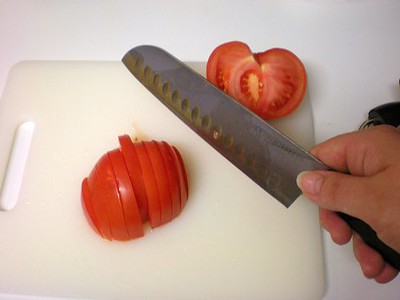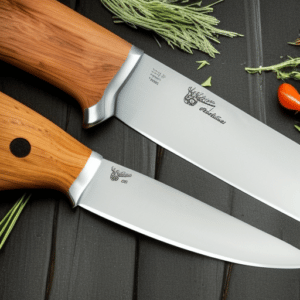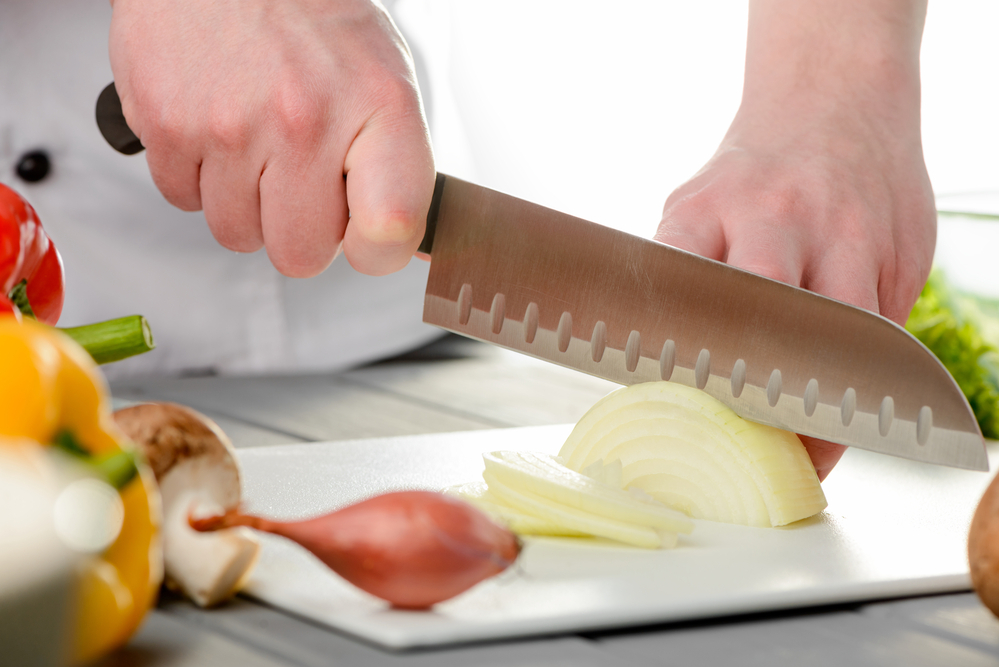Have you ever heard of Santoku knives? Santoku knives are among the most popular go-to utensils for would-be chefs and cooking enthusiasts. Alongside the chef’s knife, the Santoku is one of the most versatile products you can own, capable of performing necessary functions for a myriad of dishes.
But what is a Santoku knife used for? Despite the popularity of Japanese knives, many people still aren’t sure what the Santoku blade is and its intended use. If you are unfamiliar with a Santoku knife’s purpose, you may struggle to use the right cooking equipment and supplies when preparing your favourite foods.
Today, we will introduce you to the basics of Santoku knives and how they differ from the standard western-style chef’s knife.
What Is a Santoku Knife?
A Santoku knife is a kind of Japanese chef’s knife. The word “Santoku” translates to “three virtues”, which people usually reference when discussing what the Santoku knife can do: mincing, chopping, and slicing. The three virtues can also refer to the various parts of the blade – the heel for chopping, the main edge for slicing, and the tip for more detailed, thin slides.
Santoku blades rank among the most popular chef’s knives because they’re so versatile as kitchen utensils. You can use this Japanese kitchen knife like a paring knife or boning knife and precision slicing.
Santoku knife features vary depending on the kind of knife you buy. However, most Santoku knives are lighter and smaller than the standard western-style chef’s knife. The blade length usually measures between 6 and 7 inches, with a shorter, wider blade and flatter cutting edge. The curved tip also allows for more detailed work than the standard chef’s knife.
Another prominent feature of Santoku blades is the scalloped or Granton edge which features small indentations. A Granton edge allows tiny pockets of air to get between the ingredients and the blade, which helps stop them from sticking to a straight edge. This makes the Santoku blade one of the best choices for creating uniform slices of fish and meat or very thin slices. You can also mince very delicate herbs with the thinner blade and scoop ingredients with the large width of the metal.
The ultra-slim nature of the Chef knife means it’s ideal for very specific tasks, like chopping herbs. However, many people also use this kind of knife for more general tasks.
What Is the Point of a Santoku Knife?
The unique features of a Santoku knife, with its slightly curved blade and extra-sharp edge, make it an excellent alternative to most chef’s knives for detailed work. These knives are intended mainly for slicing, dicing and mincing, and have a very narrow edge so you can chop with a rocking motion, allowing for quick activities in the kitchen.
Interestingly, these knives’ blade angles and thinner steel have evolved from traditional Japanese vegetable knives previously used for dicing fruits. As a result, the blade can provide a more refined slicing feature than the French or German knives many of us are used to in the kitchen.
Notably, everything from the length of the blade to the use of specific materials in the Santoku knife can affect its uses in the culinary world.
Can You Use a Santoku Knife to Cut Meat?

As mentioned above, Santoku knives are excellent general-purpose knives in many kitchens because you can use them for all kinds of slicing and chopping. Cutting meat is an option with the Santoku knife, although many professional chefs prefer to use an alternative chef’s knife to avoid dulling the knife.
The shape of the blade and its rock chop motion make it ideal for mincing and dicing, and precision cutting, rather than cutting large slabs of meat. Notably, the Santoku knife has a shorter blade; hence it cannot carve meat easily, plus cutting through bones is rarely an option.
You can, however, use your Santoku’s blade for cutting very fine slices of meat and feat. Slicing meats like steak and salmon can be much easier than a standard Western chef knife when using a Santoku blade.
Can a Santoku Knife Replace a Chef’s Knife?
Though a Santoku knife has a lot of potential uses, professional chefs wouldn’t use it to replace the Western chef knife completely. To avoid a dull knife and a worn blade, you’ll need numerous kitchen knives for different purposes. It’s best to have a range of other chefs’ knives with different blade lengths and widths to tackle various practices.
Using the high-carbon Japanese steel on a Santoku blade instead of your general-purpose knives could mean you wear down the blade with your slicing activities. Many professional chefs have a selection of different knives, some with single-bevel metal, others with a double bevel, sheep’s foot tip designs, and so on.
Notably, whether you’re using your Santoku knife for multiple cutting techniques or just one purpose, it’s important to sharpen your knives regularly after each use. Home cooks and chefs alike will find their investments last longer with regular sharpening.
How to Cut With a Santoku Knife: Tips and Tricks
A Santoku knife is an excellent investment in your kitchen. Because this knife is a little smaller than the average chef’s knife, you might find it less intimidating on your cutting board. Of course, both the Santoku knife and the standard chef knife require a little practice.
Use the Backup to Down Front Motion
With a standard set of chef knives, it’s common to use the curved edge of the chef knife for the rock-chop motion. The design of a Santoku knife doesn’t have the same curved edge, which allows it to rock on the cutting board. You’ll need to hold the Santoku at the handle with a pinched grip and perform a backup to down-front motion. Every cut pushes the blade forward slightly without the rocking motion of a chef’s knife.
Mind Your Fingers!
Because you’re not using the rock-chop motion of a chef’s knife, you’ll find your knife loses contact with the board with each cut. So keep the fingers of your hand to hold your ingredient turned inwards to protect them as you chop.
When using a Santoku knife vs a chef’s knife from France or Germany, you’ll use your forefinger and thumb to gently pinch the blade to give you more control over your chopping. The blade will curve as it gets closer to the tip, giving you more precision when working on certain ingredients.
Focus On the Top of the Blade
If you’d like to rock your Santoku knives when mincing your herbs, you’ll need to focus on the top of the blade. Remember to be gentle so you will not damage the edge of your blade if you’re resting too much on the front of the knife.
Like your chef knives, you’ll have to invest in a knife sharpener. However, too much sharpening can also wear your knives out over time.
What to Remember When Using Santoku Knives

Santoku knives aren’t like chef’s knives from France or Germany. However, they can be an excellent addition to your cutting board and kitchen knife collection. The average chef’s knives come with blade lengths up to 14 inches long, whereas the cutting edge for a Santoku knife is much shorter.
It’s also worth noting that your western knife and Japanese knife materials might differ. Before you invest, you may need to look into the various forms of metal and steel used by Japanese knife creators. Thus, you have to keep an eye on the difference between single and double-bevel knives.
As with most kitchen knives, different materials can make all the difference to your performance. For example, some products come with high-carbon steel or specialist Damascus steel.
While there’s no one-size-fits-all to choosing the Japanese knives, you’ll find the more you experiment with the wide blade and pointed tip of the Santoku knife, the more comfortable you’ll be in using it alongside your other kitchen knives. Furthermore, you might discover a special length or specific style of knife that works best in your kitchen.
Santoku Knife as One of Your Kitchen Essentials
So, is a Japanese knife better than a standard chef’s knife? Well, Santoku knives, like any chef’s knives, have distinct benefits and advantages compared to other kitchen knives. With the ultra-thin cutting edge and pointed tip, the Japanese knife is excellent for when you want to mince various herbs or cut ultra-thin slices of fish and meat.
However, the ideal knife for you will depend on your cooking style and the dish you plan to serve. If you’re cooking a menu heavy on fish, vegetables, and fruit, with less meat, a Santoku knife might be the best choice. On the other hand, If you want a robust cutting edge, a double-bevel chef’s knife might be able to carve meat and cut through bones much easier than a Japanese knife.
Rather than one particular kind of knife over another for your kitchen, it’s best to look at all of your chef knife options individually and with an open mind. Explore the specific benefits and unique abilities of a western-style knife blade for chopping meat and other hard products, then switch your knife’s blade to Japanese when you want more precision.
Surprisingly, one type of kitchen knife won’t be enough to help you in your cooking. You’ll need more than just one chef knife selection to create a wide range of delectable meals and experiment with different foods in the kitchen.

